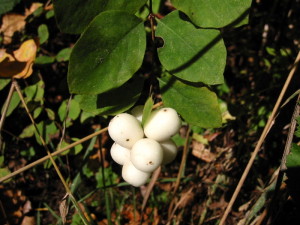Symphoricarpus racemosus commonly known as the snowberry, waxberry, or ghostberry, is a small genus of about 15 species of deciduous shrubs in the honeysuckle family,Caprifoliaceae. With the exception of the Chinese coralberry, S. sinensis, which is indigenous to western China, all species are native to North and Central America.
Contents
Uses
Temporary relief of symptoms associated with morning sickness: nausea and vomiting, gastric problems, depressed appetite.
Benefits
Symphoricarpus racemosus was commonly employed medicinally by several native North American Indian tribes who valued it especially for the saponins it contains. These saponins can be toxic, but when applied externally they have a gentle cleansing and healing effect upon the skin, killing body parasites and helping in the healing of wounds.
The native Americans used it to treat a variety of complaints but especially as an external wash on the skin. The plant is little, if at all, used in modern herbalism. Any internal use of this plant should be carried out with care, and preferably under the supervision of a qualified practitioner. See the notes above on toxicity.
The whole plant is disinfectant, diuretic, febrifuge and laxative. An infusion of the stems has been drunk to treat stomach problems and menstrual disorders. A decoction of the leaves has been used in the treatment of colds. A poultice of the chewed leaves has been applied, or an infusion of the leaves has been used as a wash, in the treatment of external injuries. A weak solution of the stems and leaves has been used as a wash for children whilst a stronger solution is applied to sores.
The fruit has been eaten, or used as an infusion, in the treatment of diarrhoea. An infusion of the fruit has been used as an eye wash for sore eyes.The berries have been rubbed on the skin as a treatment for burns, rashes, itches and sores. The berries have also been rubbed on warts in order to get rid of them – this treatment needs to be carried out at least three times a day for a period of a few weeks. A poultice of the crushed leaves, fruit and bark has been used in the treatment of burns, sores, cuts, chapped and injured skin. An infusion of the roots has been used in the treatment of fevers (including childhood fevers), stomach aches and colds. A decoction of the root bark has been used in the treatment of venereal disease and to restore the flow of urine.
An infusion of the root has been used as an eyewash for sore eyes. An infusion of the whole plant has been drunk and also applied externally in the treatment of skin rashes. A decoction of the roots and stems has been used in the treatment of the inability to urinate, venereal disease, tuberculosis and the fevers associated with teething sickness.
Caution
The fruit contains saponins. Although toxic, these substances are very poorly absorbed by the body and so tend to pass through without causing harm. They are also broken down by thorough cooking. Saponins are found in many plants, including several that are often used for food, such as certain beans. It is advisable not to eat large quantities of food that contain saponins but it would take extremely large doses of many kilos of fruit from this plant in order to produce toxic symptoms. Saponins are much more toxic to some creatures, such as fish, and hunting tribes have traditionally put large quantities of them in streams, lakes etc in order to stupefy or kill the fish.
Interactions
None are recorded.
Other names
snowberry, waxberry, or ghostberry
Reference
Source: Wikipedia, https://en.wikipedia.org/wiki/Symphoricarpos
NaturalMedicinalHerbs, http://www.naturalmedicinalherbs.net/herbs/s/symphoricarpos-albus-laevigatus=snowberry.php

